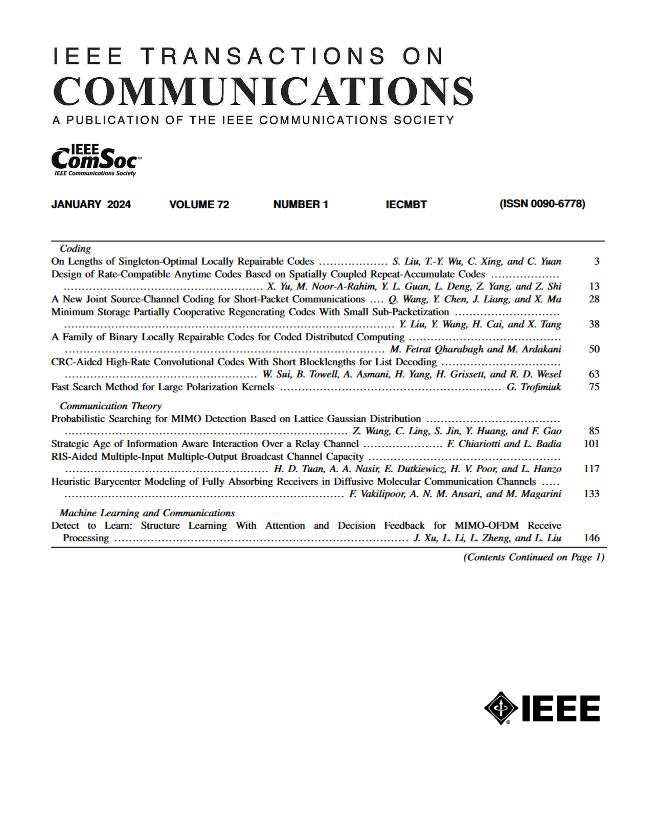提高可见光通信物理层安全性能的概率星座整形实用设计
IF 8.3
2区 计算机科学
Q1 ENGINEERING, ELECTRICAL & ELECTRONIC
引用次数: 0
摘要
为提高可见光通信(VLC)物理层安全性能,研究了一种概率星座整形(PCS)的实用设计。特别地,我们考虑了一个采用概率形M-ary脉冲幅度调制(PAM)星座的窃听VLC信道。考虑合法用户信道的可靠性要求、无闪烁传输要求和对称星座分布要求,在已知和未知窃听者信道状态信息(CSI)情况下,研究了使调制约束保密容量或窃听者信道误码率(BER)最大化的最佳星座分布。为了明确信道可靠性的约束条件,导出了任意符号概率下M-ary PAM的上界和近似误码率的可处理的封闭表达式。由于非凸误码约束,设计问题是非凸的。通过证明误码率上界是星座分布的凹函数,给出了基于凸凹过程的次优解。我们的研究结果表明,虽然均匀信令仅在光功率超过一定值时才能满足误码率约束,但所提出的PCS设计在整个光功率区域都有效。本文还讨论了有关发射光功率的最佳星座分布的一些见解。本文章由计算机程序翻译,如有差异,请以英文原文为准。
Practical Design of Probabilistic Constellation Shaping for Enhancing Performance of Physical Layer Security in Visible Light Communications
This paper studies a practical design of probabilistic constellation shaping (PCS) for enhancing the performance of physical layer security in visible light communications (VLC). In particular, we consider a wiretap VLC channel employing a probabilistically shaped M-ary pulse amplitude modulation (PAM) constellation. Considering the requirements for reliability of the legitimate user’s channel, flickering-free transmission, and symmetric constellation distribution, the optimal constellation distributions to maximize modulation-constrained secrecy capacity or the bit error rate (BER) of eavesdropper’s channel are investigated for both scenarios of known and unknown eavesdropper’s channel state information (CSI). To formulate the constraint on the channel reliability, tractable closed-form expressions for the upper bound and approximate BER of M-ary PAM under an arbitrary symbol probability are derived. The design problem is shown to be non-convex due to the non-convex BER constraint. By proving that the upper bound BER is a concave function of the constellation distribution, a suboptimal solution based on the convex-concave procedure (CCCP) is presented. Our findings reveal that while the uniform signaling can only satisfy the BER constraint when the optical power is beyond a certain value, the proposed PCS design works in the entire region of the optical power. Some insights into the optimal constellation distribution with respect to the emitted optical power are also discussed.
求助全文
通过发布文献求助,成功后即可免费获取论文全文。
去求助
来源期刊

IEEE Transactions on Communications
工程技术-电信学
CiteScore
16.10
自引率
8.40%
发文量
528
审稿时长
4.1 months
期刊介绍:
The IEEE Transactions on Communications is dedicated to publishing high-quality manuscripts that showcase advancements in the state-of-the-art of telecommunications. Our scope encompasses all aspects of telecommunications, including telephone, telegraphy, facsimile, and television, facilitated by electromagnetic propagation methods such as radio, wire, aerial, underground, coaxial, and submarine cables, as well as waveguides, communication satellites, and lasers. We cover telecommunications in various settings, including marine, aeronautical, space, and fixed station services, addressing topics such as repeaters, radio relaying, signal storage, regeneration, error detection and correction, multiplexing, carrier techniques, communication switching systems, data communications, and communication theory. Join us in advancing the field of telecommunications through groundbreaking research and innovation.
 求助内容:
求助内容: 应助结果提醒方式:
应助结果提醒方式:


